The Bahananwa tribe live below the dramatic Blouberg mountain in Limpopo. Jacques Marais and his family get into nature’s rhythm at the African Ivory Route camp within their tribal grazing lands on the edge of Blouberg Nature Reserve.
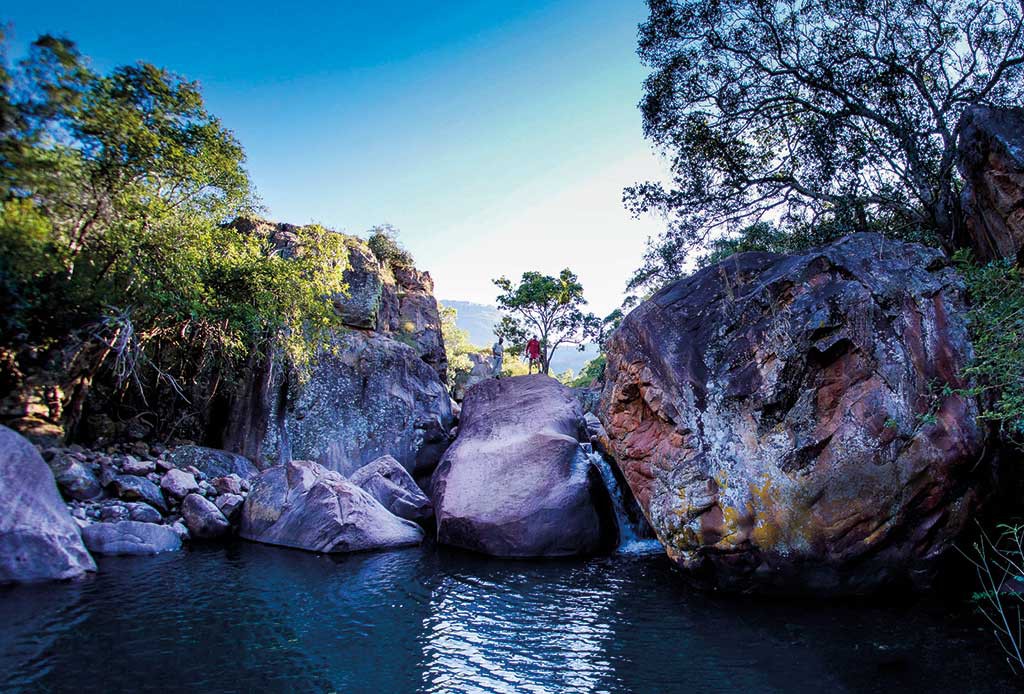
Huge boulders surround the tranquil Pools of the Whites, a couple of kilometres by foot from Blouberg Camp.
This doesn’t quite qualify as the proverbial Great Divide, you know,’ I chide myself as I contemplate the one-and-a-half-metre jump gaping at my feet. Yet my backpack feels like it weighs a good 50 kilograms, and my palms are as sweaty as a pizza addict three days into Tim Noakes’ Banting diet. The reason, I guess, is not so much the width of this leap of faith, but rather the depth of the chasm plummeting beyond the tips of my trail shoes. I lean forward to see how far the crevasse plunges onto the jagged jumble of granite below, but quickly realise this isn’t a good idea.
‘Right. Visualise a pavement,’ I mutter to myself, and before my brain is able to re-convert this mental vision of a narrow strip of concrete, I commit to my death-defying (and rather inelegant) hop. Fortunately, my fellow adventurers arrive a few minutes too late to witness my dubious athletic prowess, but in time to see me – pleased as punch – on the opposite side of the ‘abyss’.
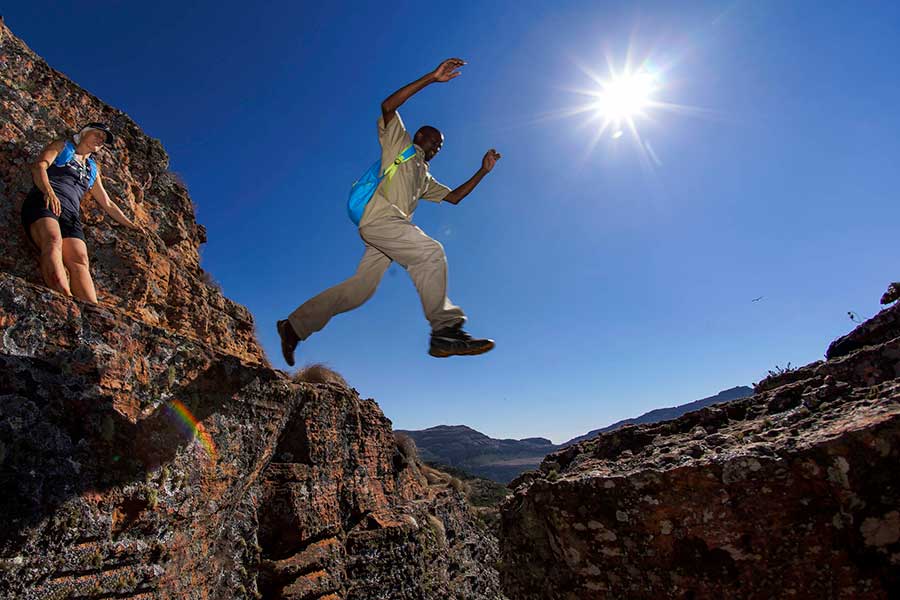
The hike to the summit includes some serious rock-hopping.
‘Wait, let me just get the camera in place,’ I holler to my rag-tag band of compadres. Our guide Khomotjo Sekiba strides across the gap as if it’s not even there, leaving my friend Pete with no choice but to grit his teeth and follow suit. But in the 30 seconds it takes to fit the fish-eye lens, my wife Karyn makes the mistake of looking down and is instantly lost to the cause. She decides to chill for a few minutes while we edge onto the scalp-tingling cliff plunging down to the wooded savanna plains below. We grab some photos of the breathtaking Blouberg landscape, then head back to jump the gap (which seems to have miraculously shrunk) for the second time.
We’re not home and dry yet, as the scramble to the summit follows a sketchy line along a near-vertical rock face bristling with thick and tangled brush. As we sit catching our breath, a shadow falls across us, blocking out the warmth of the afternoon sun. It’s a colossal Cape vulture, soaring so low we can literally make eye contact as it cocks its primeval head to give us the once-over. The proximity of the bird – one of the key predatory species here at Blouberg – lends it a prehistoric feel, as if a gigantic pterodactyl has graced us with a fly-past. Disappointed that no one had perished during the jump, the vulture banks into a thermal and spirals effortlessly into the cumulus clouds above.
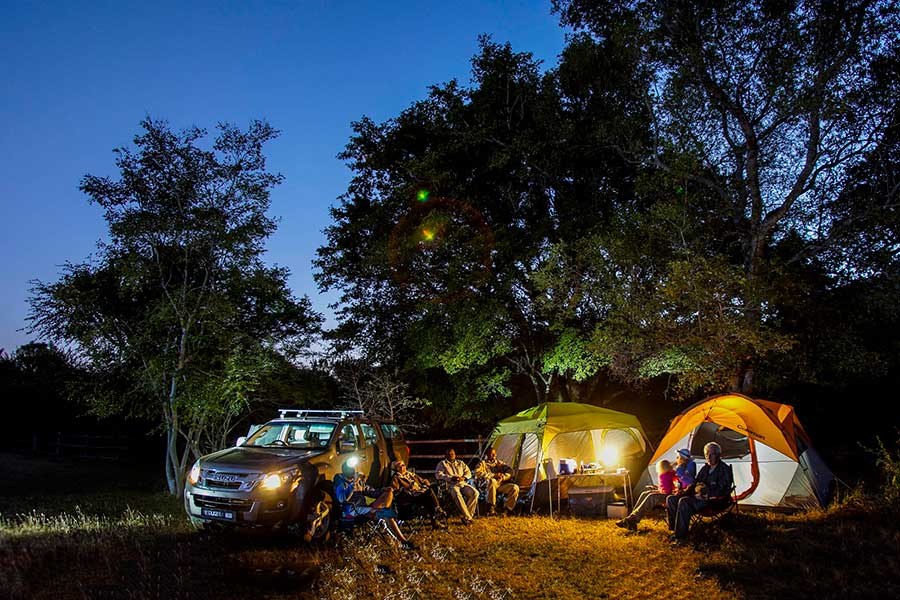
Pitching camp on the banks of the river Blouberg.
‘There is a colony of these endangered birds in Blouberg Nature Reserve,’ Khomotjo explains as we tackle the arduous descent back to camp. Although it’s only a 12-kilometre return route, the cumulative ascent is in the region of 1000 metres, much of it a major bundu-bash through thorny thickets and up a ridge littered with loose rock.
Now, I know this thigh-buster of a hike/scramble/trail run/climb may not sound like everyone’s cup of rooibos, but it rates as my personal stand-out memory of my family’s time at Blouberg. The good news is that this swathe of tribal land set within the wild heart of Limpopo offers way more than heavy doses of outdoor adrenaline.
This is a good thing, as Karyn and I have been joined on the trip by friends and family covering a wide spectrum of ages and abilities. Two-and-a-half-year-old laatlammetjie Grace loved the wide grassed space beyond the fire boma, where she could ogle the grazing Bahananwa cattle herds, before toddling off to the mountain stream a few metres beyond the camp fence to pitch pebbles at the darting pond-skaters. She joined us (in the carry-backpack, of course) on a shorter hike to Ledjiba la Makgowa, or Pools of the Whites. This leisurely two-hour return amble also proved a perfect outing for my godmother and her husband, both well into their seventies. Don’t get me wrong, these two old bullets can easily out-hike folk half their age, and once they’d performed their babysitting duties, they saddled up their mountain bikes and pedalled off down the road to the nearby village. It’s lekker to know an outdoor destination such as Blouberg can suit everyone from rock-dassie types who want to soak up the sun while ogling birds, to hardcore adventurers in search of an endorphin hit.
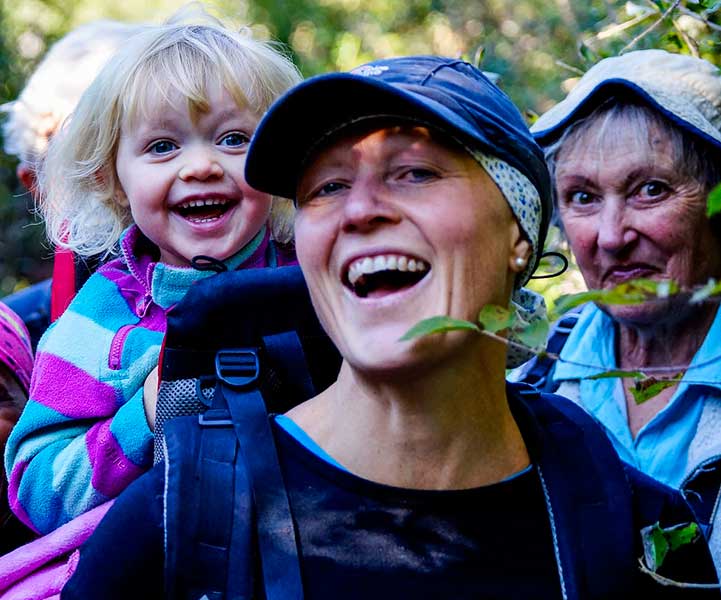
The writer’s wife Karyn and laatlammetjie Grace enjoying one of the hikes at Blouberg.
The surroundings here are breathtaking, accommodation is rustic, clean and great value, and a lack of dangerous game means you can hike, run and ride to your hearts’ content.
You can also occasionally brush shoulders with the local Bahananwa community. The guides and cleaning staff are part owners of the camp and it’s rewarding to know you’ll be contributing to its economic upliftment. The Bahananwa is a splinter group which settled here centuries ago. ‘These guys were basically like Tswana Voortrekkers, if you want, who initially moved here from Botswana because they did not want to be subjected to anyone’s authority there,’ Khomotjo explains to me. To this day, they live very much in tune with the natural rhythms ruling life at the foot of these dramatic mountains.
‘There are leopards,’ Khomotjo tells us around the fire one night. ‘But they keep to themselves in the dense mountain kloofs.’ Orange flames flicker as we huddle closer for warmth, a billion glittering stars studding the dense velvet cloak of the African night. An African wood-owl hoots in one of the fig trees lining the stream, and I wander off with my camera to see if I can get a photo of the night sky. Away from the campfire camaraderie, and with a soundtrack of river frogs, fruit bats and melodic insects, the true essence of Blouberg’s tranquillity shines through.
As I gaze up at the diamantine night sky, framed by the wraithlike branches of a giant ficus, the wood-owl takes flight in absolute silence, and with it I perceptibly feel my spirit soar into its own discreet space. My brain tells me that soon we have to leave, while my soul wants to settle, and have another week of mañanas with the Bahananwa.
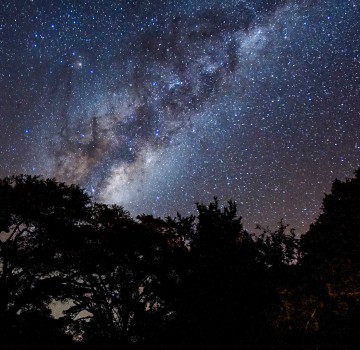
The Milky Way in all its glory.
Plan your trip
Getting there
Getting to Blouberg Camp necessitates getting off the beaten track and a 4×4 or at the very least a high-clearance vehicle is advisable. From Polokwane, head towards Dendron before turning left to Senwabarwana. After about 20 kilometres, turn right to Indermark, then left again to My Darling and right onto the D2233.
Look for the African Ivory Route signs from here; you have 12,5 kilometres of tar and four kilometres of dirt to go.
Plug these GPS co-ordinates into your navigation unit: S23.110429, E28.985469
When to go
This is proper Limpopo bush veld, so expect the summers to be cooking, with thunderstorms on a near daily basis. Visiting during autumn, spring and winter should ensure clear skies and cooler days. Winter nights are cold, so make sure to pack some warm clothing.
Need to know
Nothing is catered at the camp itself, so pack all provisions (Indermark has a good shop). The water is fine to drink, but you may find the taste off putting. Remember to pack sleeping bags and towels.
The hiking routes are unmarked, but camp staff will take you on short walks free of charge. Wood can be bought at the camp, but it is pricey.
What to do
1. Haul out your mountain bike and crank the rocky, eight kilometre return route into the nearby village for a cold beer and to hang with locals.
2. Do a spot of birding the one you really want to spot is the elusive African wood-owl. Both Cape vulture and Verreauxs’ eagle can be spotted from the camp, but hiking to the summit will get you much closer to these majestic birds.
3. Take a hike. The Pools Hike (easy three kilometres) is perfect for the whole family. If the Cliffs Hike (12 kilometres) seems a bit tough, the abandoned village on the first plateau is a good turn-around point (eight kilometres). There is also the option of summiting Blouberg Peak (16 kilometres), but you need to plan this as a full-day outing. A guided hike costs R200 a group.
4. Climb the cliffs at Blouberg, rated as among the country’s top rock-climbing destinations by the Mountain Club of SA. Tuck into a traditional meal at one of the village homes. Book through the guides and expect to pay R70 a head.
Where to stay
Blouberg Camp is part of the African Ivory Route, a Limpopo government initiative with a dozen or so camps, all marketed and managed by Transfrontier Parks Destinations.
Accommodation options include five thatched, self-catering chalets, each of which sleeps two people on comfortable beds. Ablutions are en suite and feature easy-to-use bucket showers.
Costs and contacts
It’s a 900-kilometre return trip from Johannesburg and fuel will cost roughly R2 700. Self-catering costs from R195 per person a night sharing and R100 per child under 12.
www.africanivoryroute.co.za
Please note that all prices were correct at time of publication, but are subject to change at the establishment’s discretion. Please confirm prices with them before travelling.

This article first appeared in the October 2014 issue of Getaway magazine.
You may also like
Related Posts
Wetlands are a jewel of biodiversity and incredible destinations for bird watching....
read more
Wetlands are jewels of biodiversity and incredible destinations for wildlife watching. Station yourself at one...
read more
We sent our professional reviewer, Pippa de Bruyn, to find the best accommodation in Ficksburg...
read more